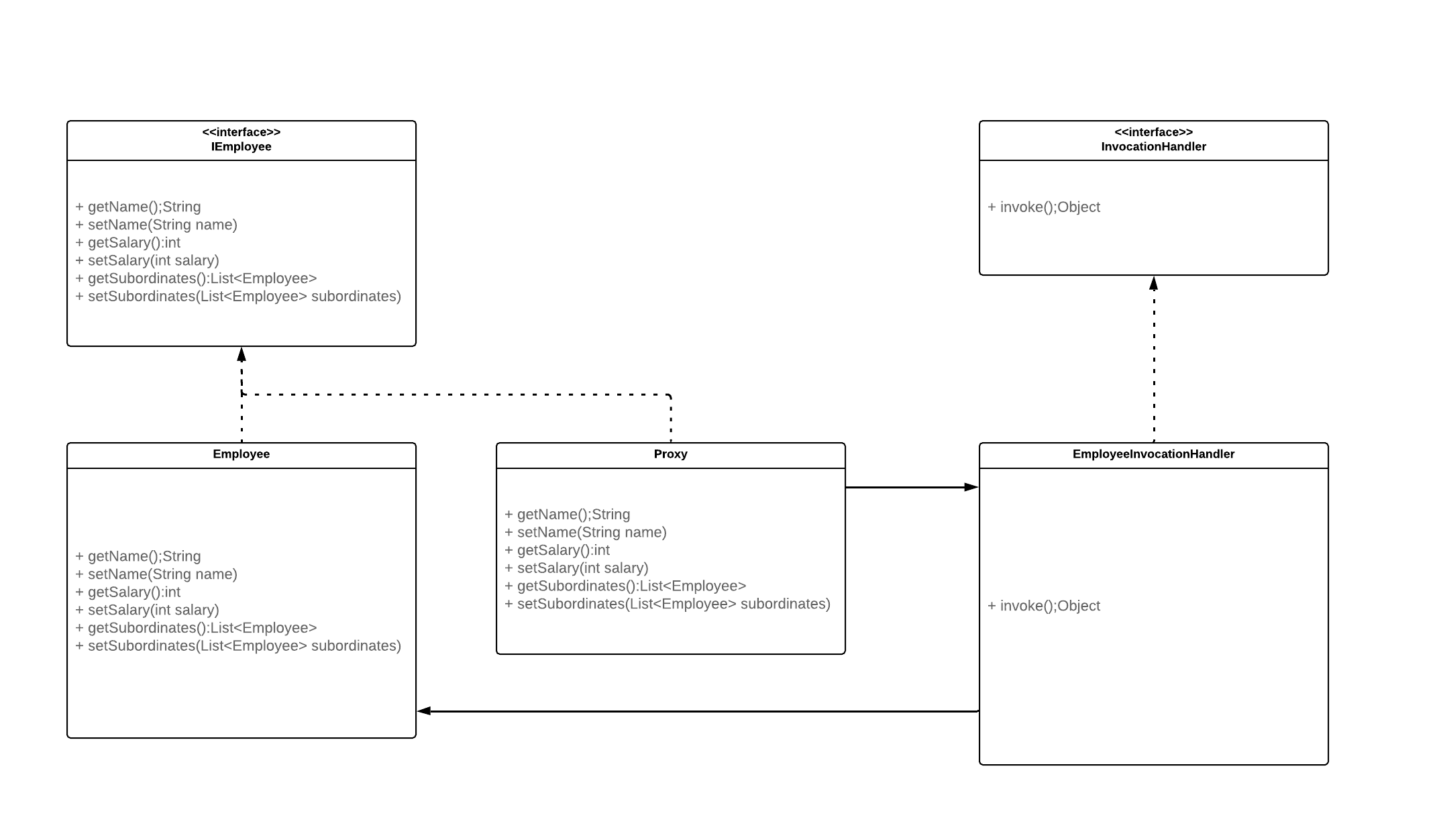Proxy Design Pattern With Real World Example In Java
Proxy Pattern or Proxy Design Pattern: Learn Proxy Design Pattern with a Real World example by looking into How Hibernate ORM works!
In this tutorial we’ll be learning about the Proxy Design Pattern. We’ll be creating one Hibernate like very simple ORM to learn about the Proxy Design Pattern.

When one Hibernate Entity has an element marked to be fetched Lazily, like,
@ManyToOne(fetch = FetchType.LAZY)
@JoinColumn(name="USER_ID")
private UserLazy user;
then it is only filled up from the database whenever you call the getter function for that attribute, i.e. getUser();.
However, you actually don’t write code for that as the plain and simple getter just returns the user object:
public UserLazy getUser() {
return this.user;
}
So, how did Hibernate fill up this variable, user, when you called the method getUser?
It can do it because Hibernate doesn’t actually work on the class that you’ve provided rather it creates a Proxy over it and it becomes the job of the proxy to fill up the elements that are lazily fetched.
A proxy is class that is used to interface something else. The proxy could interface to anything:
- a network connection,
- a large object in memory,
- a file, or some other resource that is expensive or impossible to duplicate.
In short, a proxy is a wrapper or agent object that is being called by the client to access the real serving object behind the scenes.
Let’s take one more example. The HR software allows you to access your profile. You can call several methods, like,
getName to get your name or setLeaves to update your leaves. But it will never allow you to set your salary. Your
access to the method setSalary is denied. How? because it didn’t pass the Employee object to you instead it created a
proxy over the employee object and that proxy is controlling the access. It is called protection proxy.
Now, let’s start coding. We will be creating an Employee class and one Employee Proxy class. We’ll be using Invocation Handler over here.
InvocationHandler is a part of the java.lang.reflect package and it lets you create a proxy class on the fly that
implements one or more interfaces and forwards method invocations to a class that you specify.
This is our Employee interface, i.e., IEmployee
interface IEmployee {
String getName();
void setName(String name);
int getSalary();
void setSalary(int salary);
List<Employee> getSubordinates();
void setSubordinates(List<Employee> subordinates);
}
and this interface is being implemented by our Employee class:
Note: Make sure to go through the code comments as well. It’ll help you understand the concept better.
class Employee implements IEmployee {
private String name;
private int salary;
private List<Employee> subordinates;
public String getName() {
return name;
}
public void setName(String name) {
this.name = name;
}
public int getSalary() {
return salary;
}
// the access to method should be denied by the employee
public void setSalary(int salary) {
this.salary = salary;
}
// getting the subordinates is not so straightforward
// because we've to fetch that from the RDBMS database
public List<Employee> getSubordinates() {
return subordinates;
}
public void setSubordinates(List<Employee> subordinates) {
this.subordinates = subordinates;
}
}
So, we’ve to take care of two scenarios:
- Access to the method
setSalarymust be denied. - When someone calls
getSubordinates, the attributesubordinatesmust be filled up.
To achieve this, we’ve create the following class:
class EmployeeInvocationHandler implements InvocationHandler {
// the employee that it'll proxy
private Employee employee;
public EmployeeInvocationHandler(Employee employee) {
this.employee = employee;
}
@Override
public Object invoke(Object proxy, Method method, Object[] args) throws Throwable {
// as we cannot allow the access to setSalary
// IllegalAccessException is being thrown here.
if (method.getName().startsWith("setSalary")) {
throw new IllegalAccessException("The employee cannot update their own salary.");
}
// as we cannot allow the access to setSalary
// IllegalAccessException is being thrown here.
if (method.getName().startsWith("getSubordinates")) {
List<Employee> subordinatesFromDB = fetchSubordinatesFromDatabase();
employee.setSubordinates(subordinatesFromDB);
}
return method.invoke(employee, args);
}
// this is dummy method used for fetching the subordinates.
// it sleeps for a second to simulate load and then it creates two employees
// and returns them.
private List<Employee> fetchSubordinatesFromDatabase() throws InterruptedException {
Thread.sleep(1000L);
Employee e1 = new Employee();
e1.setName("First");
Employee e2 = new Employee();
e2.setName("Second");
return Arrays.asList(e1, e2);
}
}
The method invoke of the InvocationHandler is executed whenever any method is called for the employee proxy. Inside
invoke there are some checks to handle our scenarios. It throws an exception when setSalary is called and it fills
up the collection of subordinates whenever getSubordinates is called.
Now, let’s test our code:
Here we create our employee variable, actualEmployee.
Employee actualEmployee = new Employee();
and the proxy for the employee:
IEmployee employeeProxy = (IEmployee) Proxy.newProxyInstance(
actualEmployee.getClass().getClassLoader(),
actualEmployee.getClass().getInterfaces(),
new EmployeeInvocationHandler(actualEmployee)
);
We’ve used our EmployeeInvocationHandler and actualEmployee to create the employeeProxy.
First check if we can call setName and getName. It should work because we’ve not applied any checks over them.
employeeProxy.setName("A very good Name");
assertEquals("A very good Name", employeeProxy.getName());
Calling setSalary should fail:
try {
employeeProxy.setSalary(100000000);
} catch (Exception e) {
assertEquals(IllegalAccessException.class, e.getCause().getClass());
}
and calling getSubordinates should fetch the subordinates:
List<Employee> employeeList = employeeProxy.getSubordinates();
assertEquals(2, employeeList.size());
assertEquals("First", employeeList.get(0).getName());
assertEquals("Second", employeeList.get(1).getName());
Let’s review the UML diagram

Finally the definition from the Wikipedia
A proxy, in its most general form, is a class functioning as an interface to something else. The proxy could interface to anything: a network connection, a large object in memory, a file, or some other resource that is expensive or impossible to duplicate.
I’ve created these tutorials after learning Design Patterns from this book Head First Design Patterns (A Brain Friendly Guide).
